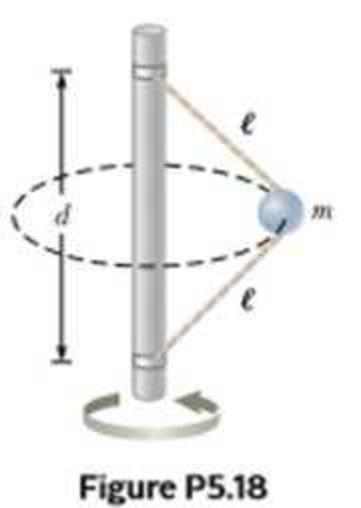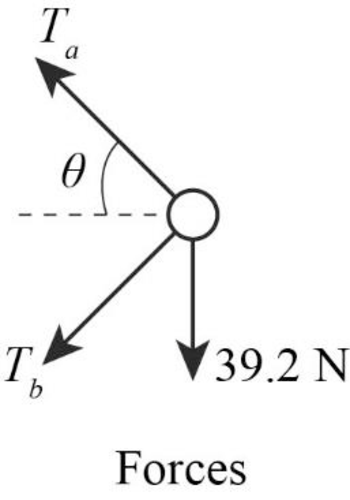
Why is the following situation impossible? The object of mass m = 4.00 kg in Figure P5.18 is attached to a vertical rod by two strings of length ℓ = 2.00 m. The strings are attached to the rod at points a distance d = 3.00 m apart. The object rotates in a horizontal circle at a constant speed of v = 3.00 m/s, and the strings remain taut. The rod rotates along with the object so that the strings do not wrap on to the rod. What If? Could this situation be possible on another planet?

The reason why the situation shown in Figure P5.18 is impossible, and whether this situation is be possible on another planet.
Answer to Problem 18P
The situation shown in Figure P5.18 is impossible, because the speed of the object is too small, the lower string is require that act like a rod and push rather than like a string and pull. This situation is only possible when
Explanation of Solution
The free body diagram of the system is shown Figure.

Write the expression for force due to gravity.
Here,
A centripetal force is needed to keep the object in the circular motion, this is equal to the force in the horizontal direction.
Here,
From the free body diagram, write the expression for net force in the
Here,
Equate equation (II) and (III).
Write the expression for force in the
Since there is no acceleration in the
From the free body diagram, write the expression for net force in the
Equate equation (V) and (VI).
Add equation (IV) and (VII).
Conclusion:
The angle
`
The radius of the orbit can be found as follows,
Substitute,
Substitute,
It indicates that lower string pushes rather than pulls.
Substitute,
Substitute,
This is possible only when
Therefore, the situation shown in Figure P5.18 is impossible, because the speed of the object is too small, the lower string is require that act like a rod and push rather than like a string and pull. This situation is only possible when
Want to see more full solutions like this?
Chapter 5 Solutions
Principles of Physics: A Calculus-Based Text
- Why is the following situation impossible? A space station shaped like a giant wheel has a radius of r = 100 m and a moment of inertia of 5.00 108 kg m2. A crew of 150 people of average mass 65.0 kg is living on the rim, and the stations rotation causes the crew to experience an apparent free-fall acceleration of g (Fig. P10.52). A research technician is assigned to perform an experiment in which a ball is dropped at the rim of the station every 15 minutes and the time interval for the ball to drop a given distance is measured as a test to make sure the apparent value of g is correctly maintained. One evening, 100 average people move to the center of the station for a union meeting. The research technician, who has already been performing his experiment for an hour before the meeting, is disappointed that he cannot attend the meeting, and his mood sours even further by his boring experiment in which every time interval for the dropped ball is identical for the entire evening.arrow_forwardA point on a rotating turntable 20.0 cm from the center accelerates from rest to a final speed of 0.700 m/s in 1.75 s. At t = 1.25 s, find the magnitude and direction of (a) the radial acceleration, (b) the tangential acceleration, and (c) the total acceleration of the point.arrow_forwardIn a classic carnival ride, patrons stand against the wall in a cylindrically shaped room. Once the room gets spinning fast enough, the floor drops from the bottom of the room! Friction between the walls of the room and the people on the ride make them the "stick" to the wall so they do not slide down. In one ride, the radius of the cylindrical room is R = 7.6 m and the room spins with a frequency of 19.7 revolutions per minute. 1) What is the speed of a person "stuck" to the wall? m/s Submit 2) What is the normal force of the wall on a rider of m = 47 kg? N Submit 3) What is the minimum coefficient of friction needed between the wall and the person? Submit Submit 5) Which of the following changes would decrease the coefficient of friction needed for this ride? 4) If a new person with mass 94 kg rides the ride, what minimum coefficient of friction between the wall and the person would be needed? increasing the rider's mass increasing the radius of the ride increasing the speed of the…arrow_forward
- A ball with a mass of .5kg is attached to a 1m string. The string is attached to a post and is free to rotate. The string can be assumed to be weightless and not stretch. The ball is spun around the post in the horizontal plane (so gravity is perpendicular to the string and direction of motion) at a rate of 2π radians per second and that is slowing down by .2 rad/s^2. What is the total acceleration vector and the tension in the string?arrow_forwardA small ball of mass m is suspended by a string of length I. The Sung makes an angie ß with the vertical. The ball revolves in a circle with an unknown constant angular speed w. The orbital plane of the ball is at a height h above the ground. Let g be the gravitational constant. You may ignore air resistance and the size of the ball. m +y +x Find an expression for the angular speed w. Express you answer in terms of some or all of the following: 1, ß, and g.arrow_forwardA certain amusement park ride consists of a large rotating cylinder of radius R = 3.15 m. As the cylinder spins, riders inside feel themselves pressed against the wall. If the cylinder rotates fast enough, the frictional force between the riders and the wall can be great enough to hold the riders in place as the floor drops out from under them. If the cylinder makes f 0.590 rotations/s, what is the magnitude of the normal force FN between a rider and the wall, expressed in terms of the rider's weight W? FN = W What is the minimum coefficient of static friction u, required between the rider and the wall in order for the rider to be held in place without sliding down? Hs 2arrow_forward
- A tetherball has a mass of 0.4kg and is attached to a string of length L=1.5 m. The string is attached to a vertical pole in the ground. The string makes an angle of θ=58∘θ=58∘ with the pole. The tetherball is moving in a horizontal circle of constant radius and constant angular velocity of 3.5rads3.5rads around the pole. The centripetal acceleration of the ball isarrow_forwardA swing ride at a carnival consists of chairs that are swung in a circle by 15.0 m cables attached to a vertical rotating pole. The total mass of a chair and its occupant is 179 kg. As the chair swings around with its rider, the cable makes an angle of 60° with the vertical. What is the tension in the cable holding the chair and the speed of the chair as it circles?arrow_forwardA small ball of mass 740.0 g is placed in a tube that is bent into a circular arc of radius R= 67.5 cm. The friction between the ball and the walls of the tube is negligible. The ball has an iron core. A magnet is used to raise the ball until it makes an angle of 5.00 degrees with the vertical, and then released from rest. What will the ball’s velocity and acceleration be at this time?arrow_forward
- A Ferris wheel has radius of 5.4 m and makes one revolution in 8.6 seconds. A person weighing 608 N is sitting on one of the benches attached at the rim of the wheel. What is the apparent weight (that is, the normal force exerted on her by the bench) of the person as she passes through the highest point of her motion? Answer:arrow_forwardA plane with a wingspan of d = 25 m loses control in flight and begins to spiral a circle around the cockpit while in a vertical dive. It completes one rotation every 1 = 2.1 s. T 100 kg? d ㅠ Submit 3 Write the expression for the speed of the tips of the wings relative to the central axis of the plane. ß a π ( 7 8 9 HOME 8 a d M^^ 4 5 6 1 2 3 h * g 1 j k m 0 END CLEAR P f t NO BACKSPACE DEL Hint Feedback I give up! What is the speed in m/s? A pilot of mass m is r = 1 meter above the axis of rotation. He experiences a centripetal force. What is the force in N if the pilot's mass isarrow_forwardA child is holding a string with a ball tied at the end. The child spins around in a circle causing the ball to travel in uniform circular motion. While doing this, the 1.3 m long string makes a 48.8◦ angle below horizontal. What is the tangential speed of the ball?arrow_forward
 Principles of Physics: A Calculus-Based TextPhysicsISBN:9781133104261Author:Raymond A. Serway, John W. JewettPublisher:Cengage Learning
Principles of Physics: A Calculus-Based TextPhysicsISBN:9781133104261Author:Raymond A. Serway, John W. JewettPublisher:Cengage Learning Physics for Scientists and Engineers with Modern ...PhysicsISBN:9781337553292Author:Raymond A. Serway, John W. JewettPublisher:Cengage Learning
Physics for Scientists and Engineers with Modern ...PhysicsISBN:9781337553292Author:Raymond A. Serway, John W. JewettPublisher:Cengage Learning

